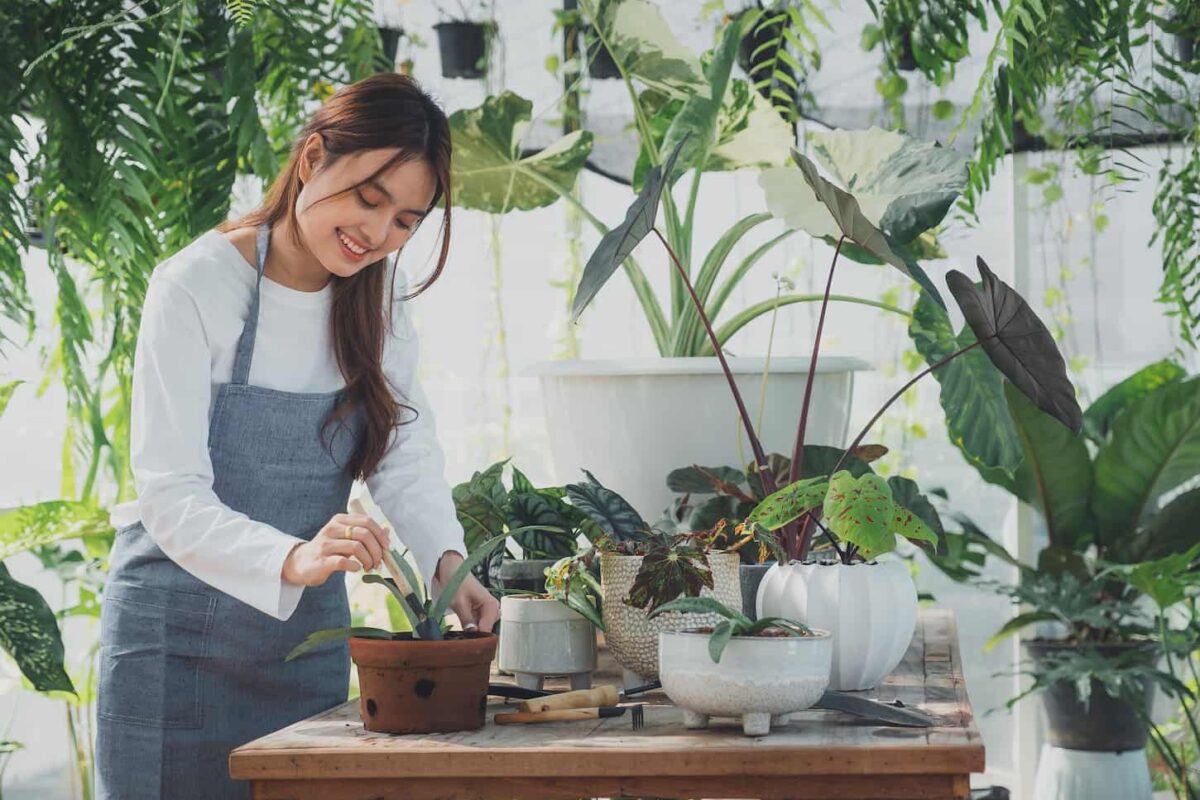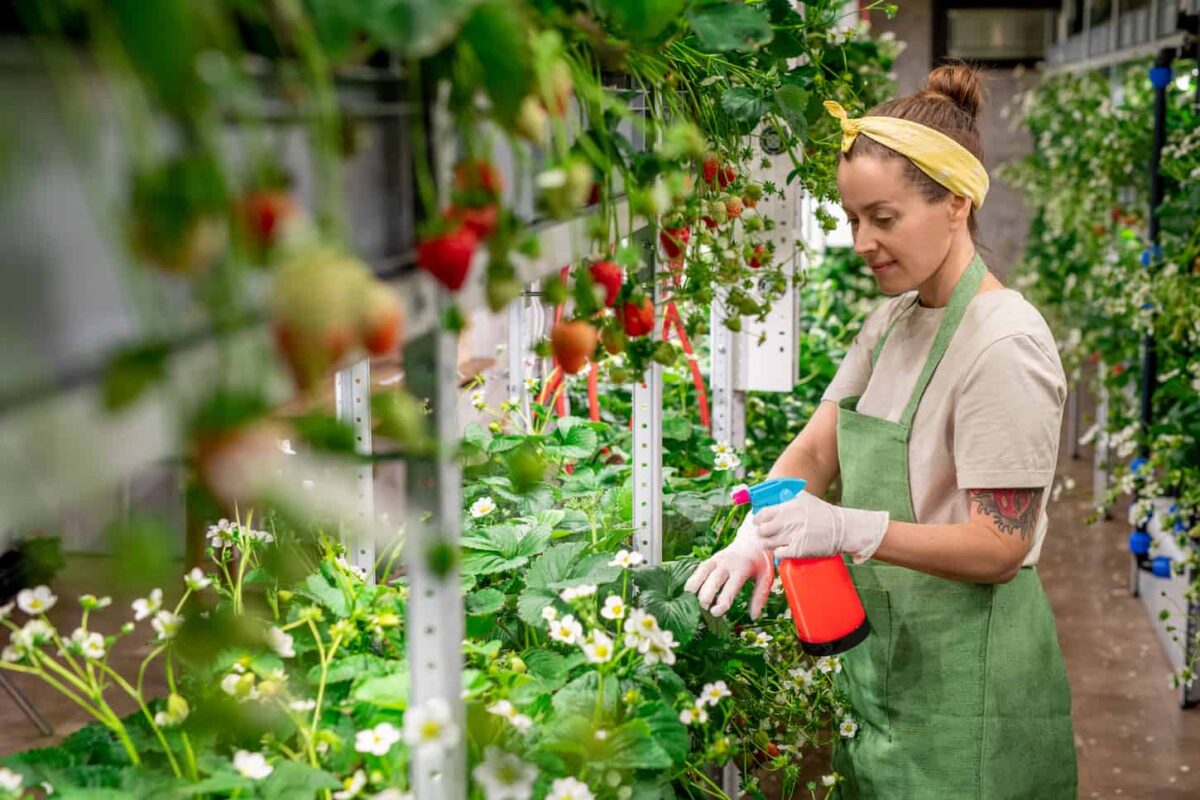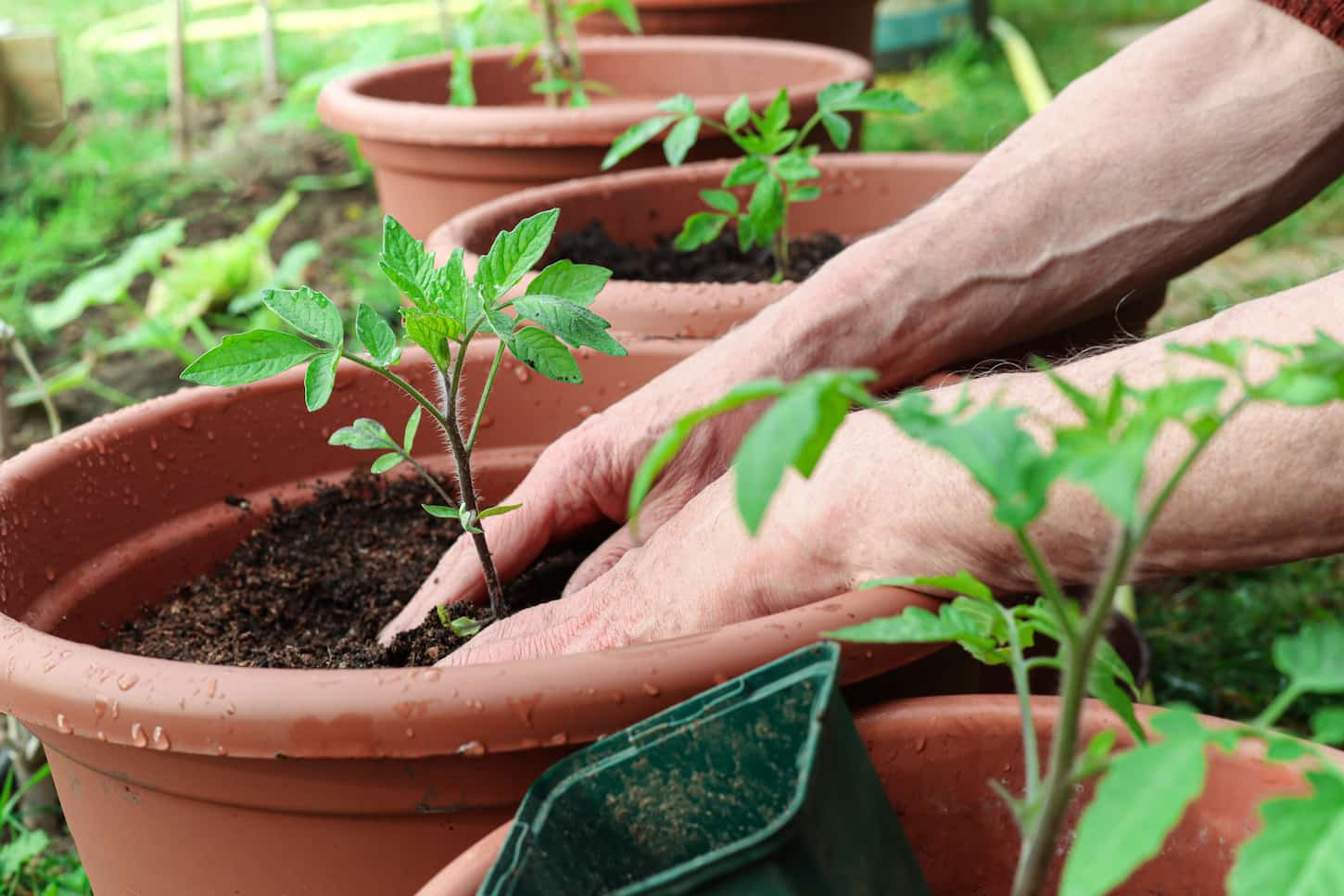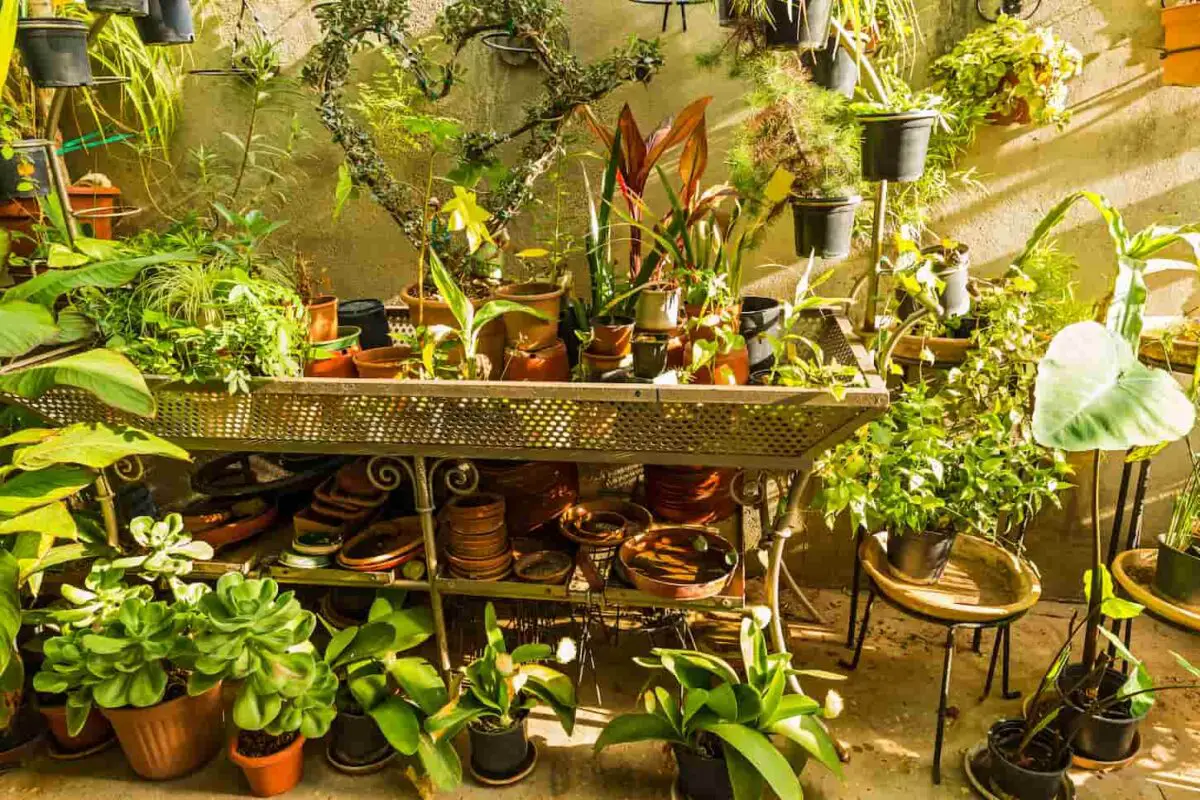Container gardening is a fantastic solution for those with limited space, allowing you to bring the joys of gardening to your balconies, porches, patios, and even indoors. Using containers lets you control your plants’ soil, sun, and growing conditions, making them perfect for small spaces and urban environments.
Container gardening in small spaces is suitable for growing vegetables and herbs, as it lets you have fresh produce at your fingertips. Container gardening can also be a fun and creative way to display your plants. Easily change the look of your garden each year or even throughout the seasons.
Ready to dive into container gardening as a beginner? Let’s do this together as we determine container sizes, locations, and how to do container gardening right.

Choosing the Right Containers
When starting your container garden, selecting the right size of containers is important to ensure your plants have ample room to grow.
For example, larger vegetables like tomatoes and squash require a 5-gallon container, while smaller, shallow-rooted plants such as lettuce or other greens will do well in more compact containers. With some planning and creativity, you’ll be on your way to enjoying a flourishing garden, no matter how small your space may be.
When venturing into container gardening in small spaces, selecting suitable containers for your plants is essential. Considering factors such as the material, size, and style of each container can vastly impact your plants’ overall health and growth. Let’s explore some sub-sections to help you choose the most appropriate containers.
Matching Container Materials to Plants
Container materials play a vital role in the growth and development of your plants. Common container materials include wood, plastic, window boxes, tubs, hanging baskets, terra cotta, and clay pots.
Each material has benefits and drawbacks, so choosing one that suits your plants’ needs is crucial.
Pro tip: Terra cotta and clay pots are excellent for plants that prefer dry conditions as they absorb excess moisture. However, plastic or glazed ceramic pots will serve you better for plants requiring consistent moisture.
Wooden containers offer a natural look and can help insulate plant roots. Pick rot-resistant wood or treat your wooden containers to prevent decay. Window boxes and hanging baskets are stylish and space-saving, perfect for small balconies or patios.
Best Container Sizes for Different Plants
Not only does the material matter, but the size of the container is equally important. Depending on their root systems and growth habits, various plants thrive in different-sized containers.
Here’s a quick reference for container sizes to match various plant types:
- Small containers (6-8 inches in diameter): Suitable for herbs, small flowers, and leafy greens.
- Medium containers (12-14 inches in diameter): Ideal for compact vegetables and most flowering plants.
- Large containers (18-24 inches in diameter): Best for larger plants, such as tomatoes, small fruit trees, and shrubs.
Spend some time researching your chosen plants’ specific needs to ensure you select the most appropriate container. Doing so will optimize their growth potential and elevate your small space container garden.
Pro tip: Always choose containers with drainage holes to prevent water from accumulating at the bottom, which can cause root rot. If a container lacks drainage holes, you can easily drill some on your own.

Selecting the Ideal Location
When it comes to container gardening in small spaces, selecting the right location is crucial. You must consider various factors like sunlight, available space, and convenience. Fortunately, there are numerous places where you can create a thriving garden, such as patios, balconies, fences, and even windowsills.
First, determining your plants’ sun exposure (sunlight requirement) is critical for their growth. Most vegetables need at least 6 hours of sunlight daily to grow successfully. Track the sun’s movement in your chosen location throughout the day to ensure the plants get enough light.
If you live in a building, observe balconies and porches, which can provide great settings for your container garden.
Your fence can also become a vertical garden by attaching pots, window boxes, or hanging planters. This creative solution maximizes space and adds visual appeal to your outdoor area.
Pro Tip: If sunlight is limited on your patio, balcony, or windowsill, consider adding reflective materials like mirrors or aluminum foil to nearby surfaces. This will help increase the sunlight exposure for your plants.
You might ponder on utilizing the inside of your home as well. Position your container garden near large windows, where your plants can receive adequate sunlight. Window boxes are perfect if you want to have a compact herb garden within reach while cooking.
Lastly, prioritize convenience. Choose a location that allows easy access to water, making it effortless to tend to your plants. Regular maintenance will be necessary to keep your container garden thriving, so always consider this when selecting the ideal spot for your green sanctuary.
Super important tip: pick an easily visible location so you remember your garden.

Growing Plants Vertically
When working with small spaces, vertical gardening can be an effective way to maximize your growing area. Growing plants upward can make the most of your limited space, creating a productive and beautiful garden.
Vertical Gardening Techniques
There are several techniques to help you achieve a successful vertical garden. Using these methods, you can create a unique garden design that fits your needs and preferences:
- Trellises and arbors: These structures can support vining plants like tomatoes, cucumbers, and beans.
- Wall-mounted planters: Attaching planter boxes to your walls or fences allows you to grow herbs, flowers, or shallow-rooted vegetables in small spaces. The Washington Post suggests using your fence to support vining plants like fig ivy and wisteria.
- Vertical planter boxes: These containers are designed to stack or hang, increasing your growing area without taking up valuable floor space. You can create a lettuce planter that grows vertically, perfect for small urban gardens.
Pro Tip: Ensure each technique you use provides adequate sunlight, water, and airflow for your plants to thrive.
Best Plants for Vertical Gardens
Not all plants are suitable for vertical gardening. When planning your garden, consider plants that are well-suited for growing upwards
| Plant Choice | Reason |
|---|---|
| Tomatoes | Indeterminate varieties can be trained to climb trellises, producing fruit throughout the season. |
| Strawberries | Grow well in vertical planters and can be easily harvested without bending over. |
| Herbs | Can thrive in small containers, making wall-mounted planters an ideal location. |
| Green leafy vegetables | Shallow-rooted and perfect for vertical planter boxes. |
That’s not to say you can’t put other kinds of plants in vertical gardens. I’ve seen some neighbors successfully grow melons (cantaloupes) and large squash (pumpkins, zucchini, and summer squash) on a vertical fence system that used fancy hammocks to support the produce.
However, that’s a far more advanced setup than most beginners will try (with good reason). It also takes a lot of work, so I’d recommend you get used to vertical gardening with easier plants first – then you can add the fancier setups with other plants.
Pro Tip: Experiment with different plant combinations to find what works best for your space and conditions. By incorporating vertical gardening techniques and selecting suitable plants, you can maximize your small space and enjoy a thriving container garden. Happy gardening!

Soil and Drainage
Choosing the right soil and ensuring proper drainage is crucial for successful container gardening in small spaces. Begin by selecting high-quality potting soil, which provides a balanced mixture rich in organic matter and well-draining properties. Incorporating compost into your soil can improve its overall quality and support the healthy growth of your plants.
Additionally, you may need to amend your soil to create an ideal growing medium. Common soil amendments include sphagnum moss, which helps retain moisture, and organic matter like aged manure, which adds nutrients. Combining these components can create a porous, well-aerated environment that encourages strong root development.
Pro Tip: Use a mix of equal parts potting soil, compost, and sphagnum moss or peat moss for a balanced growing medium.
Good drainage prevents waterlogged soil and keeps plants’ roots healthy. Ensure that your chosen container has drainage holes at the bottom, and if possible, elevate it slightly to facilitate water flow. Adding sand or pebbles at the bottom of your container can also improve drainage.
Keep an eye on your plants and adjust your watering habits accordingly. Overwatering can lead to root rot, while underwatering can stunt growth. Striking the right balance will help your container garden thrive in a small space.
Pro Tip: Observe the moisture levels in your soil regularly by sticking your finger about an inch deep into the soil. If it feels dry, it’s time to water your plants.

Watering and Feeding Your Container Garden
Watering your container garden is crucial for maintaining the health and growth of your plants. Most plants need to be watered when about half of the moisture is gone, and you should avoid waiting until the soil is completely dry.
You can estimate the moisture level by the feel of the soil or by using a soil moisture probe. Your container will also become noticeably lighter as it dries out. When watering, do so thoroughly until you see water drain out of the bottom.
Pro Tip: Choose outdoor containers no smaller than ten inches in diameter; smaller containers dry out too quickly and plants can quickly become root bound. Larger containers hold more soil and moisture while allowing roots to grow and absorb water and nutrients.
Feeding your container plants with the right amount of fertilizer is essential to promote healthy growth.
- Start by choosing a fertilizer specifically designed for container gardening.
- Generally, most fertilizers should be applied at half the recommended strength.
- Apply fertilizer every two to four weeks, depending on the plant’s specific needs.
In addition to watering and feeding, proper soil aeration can be important to some plants in container gardens. Loosen the soil in your containers every now and then to promote air circulation and prevent the growth of disease-causing bacteria.
Remember, being attentive to your container garden’s watering, feeding, and aeration needs in small spaces will ensure your plants thrive and grow successfully.
Growing Vegetables and Fruits
Container gardening allows you to enjoy the benefits of growing your own vegetables, fruits, and herbs, even in small spaces. You can easily create a bountiful harvest on your balcony or patio with the right choice of containers and plants.
Top Container Vegetables and Fruits
When selecting plants for your container garden, consider their growth habits, space requirements, and nutrient needs. Here are some of the best vegetables and fruits for container gardening:
- Lettuce – This leafy green can be grown in shallow containers, making it an excellent option for small-space gardening. Choose from various types and colors to create a visually appealing arrangement. Lettuce requires at least 12 inches of soil depth.
- Tomatoes – Choose compact varieties such as cherry or patio tomatoes, as they are well-suited for container growing. A 5-gallon container is a good size for tomato plants.
- Peppers – Bell and hot peppers can be grown in containers, too. They require at least 12 inches of soil depth and benefit from consistent watering and occasional fertilizing.
- Cucumbers – Opt for bush varieties of cucumbers instead of vining types. These compact plants can save space and still provide plenty of fruit.
- Radishes – This fast-growing root vegetable can be direct seeded into a 2- to 5-gallon container. Thin to 3 inches apart after sprouting so they have room to grow.
Other container-friendly vegetables include broccoli, spinach, pole beans, bush beans, carrots, kale, and eggplant. For fruits, consider growing strawberries, blueberries, or dwarf varieties of fruit trees. Herbs such as basil, cilantro, and oregano are also excellent container plants.
By carefully selecting the right plants and containers and providing proper care, you can enjoy a thriving container garden and enjoy fresh, home-grown produce even in the smallest of spaces!
Pro tip: Opt for self-watering containers or add a layer of mulch to help retain moisture and keep your plants healthy.

Growing Herbs and Flowers in Containers
Container gardening is a fantastic solution for small spaces, allowing you to grow beautiful flowers and fresh herbs on your balcony, patio, or indoors. In this section, we’ll cover some popular container herbs, and attractive container flowers and share valuable pro tips to help you make the most of your limited garden space.
Popular Container Herbs
The following fresh herbs are ideal for container gardening:
- Mint
- Rosemary
- Basil
- Chives
- Parsley
- Oregano
- Thyme
When planting herbs in containers, consider using self-watering pots for species like chives, parsley, and mint, which thrive in constantly moist soil. Regular containers are a better option for herbs that prefer to dry out between watering, such as oregano and rosemary.
Pro Tip: Pair herbs with similar water needs together in the same container to simplify maintaining your garden.
Attractive Container Flowers
For stunning container gardens, try incorporating some of the following flowers:
- Geranium
- Fuchsia
- Succulents
Geraniums and fuchsias are gorgeous flowering plants that perform well in containers. Their bright colors and elegant forms will surely catch the eye. Succulents are also a great option for container gardening as they require little water and come in various shapes and colors.
Pro Tip: Enhance your overall container garden by adding sphagnum moss around the plants. This adds extra visual appeal and helps retain moisture, so you don’t have to water as frequently.
Combining herbs with attractive flowers in your container garden is a fantastic way to enjoy your small space’s beauty and practical benefits.

Maximizing Space with Creative Solutions
Regarding container gardening in small spaces, you can maximize your space by using creative solutions. One great option is to utilize raised beds. Raised beds clearly separate different gardening tasks and help effectively utilize vertical space, especially with trellises.
You can easily grow different plants in a small area, ensuring a productive garden even in limited spaces.
Another excellent idea to make the most of your space is repurposing old items as planters, like an old garden cart or a rusty ladder. Not only will this add character and charm to your garden, but it will also give your plants a unique home.
One of my favorite repurposed items was an old bicycle with a basket on the front. The bicycle was a great decor piece, and the basket was upcycled into a garden container full of gorgeous flowers.
Pro tip: Transform an old cart or ladder into a mobile container garden that can be moved around as needed. This allows you to easily adjust the placement of your plants based on sunlight requirements and curb appeal.
When it comes to gardening in small spaces, creativity is key. Experiment with different planter options, such as hanging baskets, vertical gardens, and tiered stands. These can help you maximize limited space while making your container garden look full and lively.
Finally, don’t forget to have fun and let your personality shine through in your container garden. Adding pops of color or quirky elements will increase your garden’s overall visual appeal and delight you and your visitors.
Pro tip: Mix and match a variety of plants with different textures, colors, and heights for a visually impactful display that’s sure to impress.
Key Takeaways
Container gardening is a great choice for anyone who wants to grow plants but has limited space, mobility issues or concerns, or wants to grow plants that may not be suitable for their garden soil. Containers provide ideal growing conditions, and they’re easily accessible and can be moved around as needed.
To make container gardening easy, choose a container with good drainage and select plants that are suitable for container gardening. Start with good soil and compost, water regularly, and move your containers around to provide the right amount of sun and shade for your plants.
With these tips, you can enjoy growing plants in a small space or with less effort.
Resources
Learning from your own experience is essential, but learning from others is also intelligent. These are the sources used in this article and our research to be more informed as homesteaders.
- Beck, A. (2022). Grow These 13 Herbs in Pots for a Fragrant Garden Almost Anywhere. Better Homes & Gardens. https://www.bhg.com/gardening/vegetable/herbs/best-herbs-for-container-gardens/
- Container Gardening | OSU Extension. (n.d.). https://extension.osu.edu/today/container-gardening
- Container Vegetable Gardening for Beginners. (n.d.). Almanac.com. https://www.almanac.com/content/container-gardening-vegetables
- Crow, R., Cottrell, A. K., & Dubuis-Welch, C. (2022). Container gardening – 10 steps to growing plants in pots and ideas to make them look gorgeous. Real Homes. https://www.realhomes.com/advice/container-gardening-for-small-spaces
- Gardenuity. (2020). How to Pick the Best Location for a Container Garden. THE SAGE. https://blog.gardenuity.com/best-location-container-garden/
- Hailey, L. (2023). 15 Tips For Vegetable Gardening in Small Spaces. All About Gardening. https://www.allaboutgardening.com/gardening-limited-space/
- Lady, G. (2022, September 15). A container garden for small spaces: all you need to know • Sow Small Garden. Sow Small Garden. https://sowsmallgarden.com/container-garden/
- Neveln, V. (2023). How to Grow Vegetables in Containers for a Plentiful Garden. Better Homes & Gardens. https://www.bhg.com/gardening/vegetable/vegetables/growing-vegetables-in-containers/
- Strauss, M. (2023). 4 Ways to Grow Vertical Gardens in Small Spaces. Epic Gardening. https://www.epicgardening.com/vertical-garden/
- Utah State University. (n.d.). Container Gardening Tips. USU. https://extension.usu.edu/archive/container-gardening-tips
- Vanover, L. (2020, June 19). 6 Tips for Watering Container Gardens. Birds and Blooms. https://www.birdsandblooms.com/gardening/small-space-gardening/tips-for-watering-container-gardens/
- Wellbank, L. (2023, April 5). Add lushness to a small yard or patio with a vertical garden. Washington Post. https://www.washingtonpost.com/home/2023/04/05/how-to-vertical-garden-small-space/